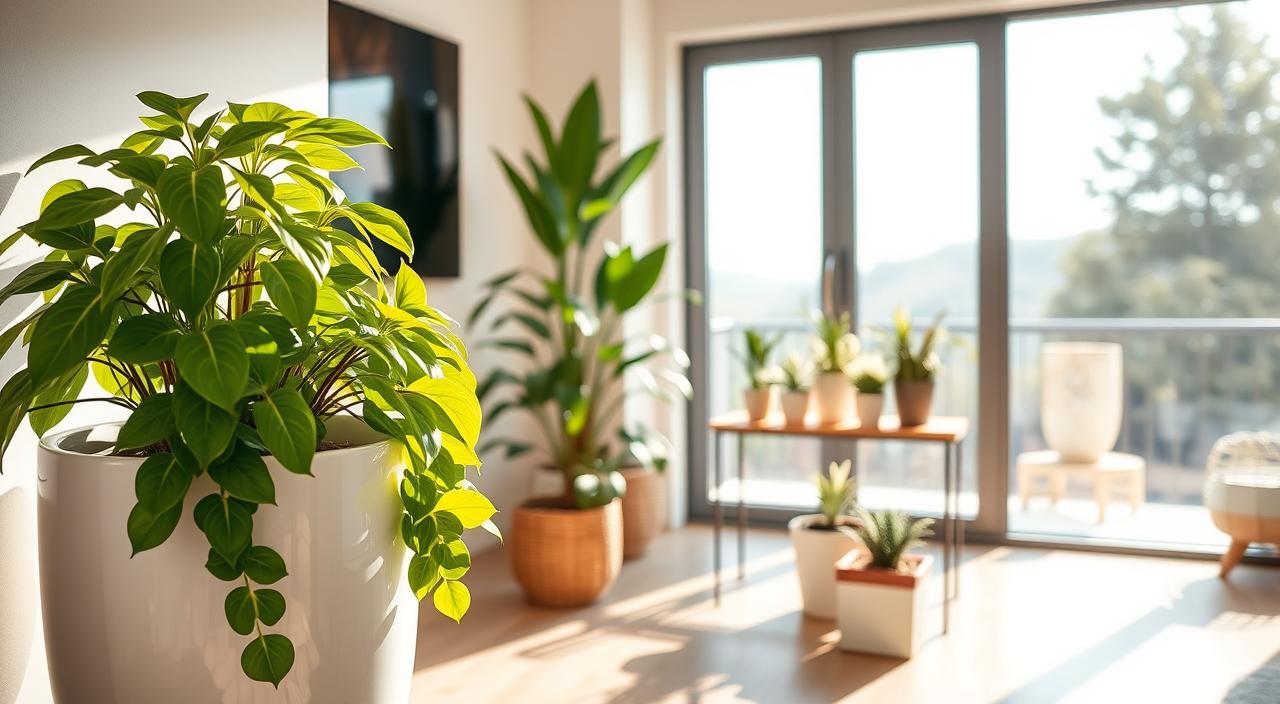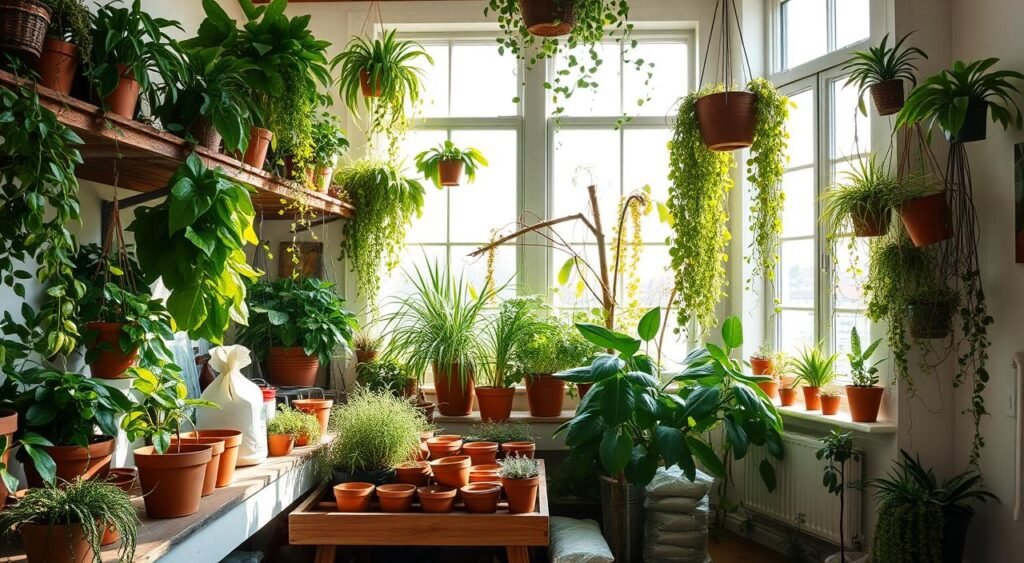Did you know that incorporating houseplants into your living or working space can boost your productivity by up to 15 percent? Studies have shown that being around indoor plants can significantly reduce stress levels and improve overall well-being.
Indoor plants have become a popular choice for home decor due to their numerous benefits. Not only do they add a touch of vibrancy to a room, but they also play a crucial role in enhancing indoor air quality. With a wide variety of plants to choose from, anyone can find the perfect addition to suit their space and style, making indoor gardening a rewarding hobby.
Key Takeaways
- Boosts productivity by up to 15 percent
- Reduces stress levels
- Improves overall well-being
- Enhances indoor air quality
- Variety of plants to choose from for any space
What Are Indoor Plants?
Indoor plants are not just decorative elements; they play a significant role in enhancing indoor air quality and promoting well-being. These plants are grown indoors, typically in pots or containers, and can be used to add a touch of nature to any room.
Indoor plants are a diverse group of plants that can thrive in indoor environments. They come in various shapes, sizes, and types, offering a wide range of choices for indoor gardening enthusiasts.
Defining Indoor Plants
Indoor plants are defined as plants that are grown indoors, away from the direct impact of outdoor weather conditions. They are often used for decorative purposes, to purify the air, and to create a calming atmosphere.
These plants can be categorized into different types based on their growth habits, lighting requirements, and maintenance needs. Understanding these categories can help in selecting the right plants for specific indoor environments.
Popular Types of Indoor Plants
Some of the most popular types of indoor plants include snake plants, spider plants, and succulents. Snake plants are known for their ability to purify the air, while spider plants are easy to care for and propagate. Succulents are low-maintenance and come in a variety of shapes and sizes.
| Plant Type | Lighting Needs | Maintenance Level |
|---|---|---|
| Snake Plants | Low to Medium | Low |
| Spider Plants | Medium to Bright | Medium |
| Succulents | Bright | Low |
When choosing indoor plants, it’s essential to consider factors such as lighting conditions, watering needs, and the level of maintenance you’re willing to undertake. By selecting the right plants, you can enjoy the numerous benefits they offer, from improved air quality to enhanced aesthetic appeal.
Benefits of Having Indoor Plants

Bringing plants indoors can transform your space and improve your health in several ways. Indoor plants are known to have numerous benefits, ranging from improving air quality to enhancing mental well-being.
Improved Air Quality
One of the most significant advantages of having indoor plants is their ability to purify the air. Air-purifying plants like spider plants and snake plants are known to remove toxins and pollutants from the air, creating a healthier indoor environment.
- Spider plants are effective at removing air pollutants.
- Snake plants are known for their ability to purify the air even at night.
- Peace lilies are another example of plants that can improve indoor air quality.
Stress Reduction and Mood Enhancement
Indoor plants can also have a positive impact on mental health by reducing stress levels and boosting mood. The presence of plants has been shown to create a calming atmosphere, which can be particularly beneficial in today’s fast-paced world.
Caring for indoor plants can be therapeutic, providing a sense of accomplishment and connection to nature. This can be especially true for plants that require regular maintenance, such as watering and pruning.
Increased Humidity Levels
Some indoor plants, like peace lilies and ferns, can increase humidity levels in dry environments. This can be beneficial for people who suffer from dry skin or respiratory issues.
By incorporating indoor plants into your home or office, you can not only enhance the aesthetic appeal of your space but also improve your health and well-being. Proper plant care is essential to maintaining the benefits of indoor plants.
Choosing the Right Indoor Plants
The journey to finding the perfect indoor plants involves considering several key factors. Lighting, pet-friendliness, and maintenance level are crucial elements to consider when selecting plants that will thrive in your home.
Low-Light Indoor Plants
For rooms with limited natural light, low-light plants are the perfect solution. Plants like Chinese Evergreen and Pothos are not only beautiful but also capable of surviving in conditions with minimal lighting. These plants are ideal for spaces that lack sufficient sunlight, making them a great choice for indoor gardening.
Pet-Friendly Options
If you have pets, it’s essential to choose pet-friendly indoor plants to ensure their safety. Plants like Spider Plants and Parlor Palms are non-toxic to animals, making them excellent choices for pet owners. These plants allow you to enjoy the benefits of indoor gardening while keeping your pets safe.
Plants for Beginners
For those new to indoor gardening, low-maintenance plants are the way to go. Snake Plants and ZZ Plants are great choices for beginners due to their ability to thrive with minimal care. These plants are forgiving if you forget to water them from time to time, making them perfect for busy individuals or those just starting out with indoor gardening.
Essential Care Tips for Indoor Plants

The key to enjoying lush, vibrant indoor plants lies in providing them with the right care. Proper care encompasses several critical aspects, including watering techniques, lighting conditions, and soil fertilization.
Watering Techniques
Watering is one of the most crucial aspects of indoor plant care. Overwatering is a common mistake that can lead to root rot and other issues. To avoid this, it’s essential to check the soil moisture before watering. Stick your finger into the soil up to the first knuckle; if the soil feels dry, it’s time to water.
- Water plants in the morning to give them the entire day to absorb the water.
- Use room-temperature water to avoid shocking the roots.
- Adjust your watering schedule according to the season, as plants generally require less water in the winter.
Proper Lighting Conditions
Lighting is another vital factor in indoor plant care. Most indoor plants prefer bright, indirect light, but some can tolerate low light conditions. Understanding the lighting needs of your plants is crucial for their survival.
- Place plants that require bright light near east- or west-facing windows.
- Use grow lights for plants that need more light than your home can provide naturally.
- Avoid placing plants in direct sunlight, as it can cause leaf scorch.
Soil and Fertilization
Using the right soil and fertilization techniques can significantly impact the health of your indoor plants. A well-draining potting mix is essential to prevent waterlogged soil.
- Fertilize your plants sparingly during the growing season (spring and summer).
- Use a balanced, water-soluble fertilizer to provide essential nutrients.
- Repot your plants every year or two to refresh the soil and provide a larger pot if necessary.
By following these essential care tips, you can keep your indoor plants thriving and enjoy the many benefits they provide.
Common Indoor Plant Pests
Indoor plants, despite their beauty and benefits, can sometimes fall prey to unwanted pests. These pests can cause significant damage to the plants if not identified and managed promptly.
Identifying Common Pests
Some of the most common indoor plant pests include spider mites, mealybugs, and scale. Spider mites are tiny, spider-like insects that can cause yellowing or bronzing of leaves. Mealybugs are small, white, cottony insects that feed on plant sap, while scale insects are armored insects that attach to the plant and suck its sap.
To identify these pests, it’s essential to inspect your plants regularly. Look for signs such as white powdery patches, sticky honeydew, or actual sightings of the pests. Early detection is key to controlling infestations.
Natural Pest Control Methods
When it comes to controlling indoor plant pests, many gardeners prefer natural methods over chemical pesticides. Some effective natural pest control methods include:
- Using neem oil, which is derived from the seeds of the neem tree and can disrupt the life cycle of pests.
- Insecticidal soap, which can be used to kill soft-bodied pests like spider mites and mealybugs.
- Horticultural oil, which suffocates pests and can be used on a variety of indoor plants.
These natural methods are not only effective but also safer for the environment and human health.
Preventative Measures
Preventing pest infestations is always better than trying to control them after they occur. Some preventative measures include:
| Preventative Measure | Description | Benefit |
|---|---|---|
| Regular Inspection | Regularly inspect your plants for signs of pests. | Early detection of pest issues. |
| Keep Plants Clean | Dust and clean your plants regularly to prevent pest buildup. | Reduces the risk of pest infestations. |
| Isolate New Plants | Isolate new plants for a few weeks before introducing them to your other plants. | Prevents the introduction of pests to your existing plants. |
By following these preventative measures and being aware of the common pests and natural control methods, you can keep your indoor plants healthy and thriving.
“A healthy plant is a pest-free plant. Regular care and attention can prevent many pest issues.”
Decorating Your Space with Indoor Plants

With a little creativity, indoor plants can be used to enhance your home’s decor and reflect your personal style. Indoor plants are not just a natural way to enhance air quality; they are also a versatile decorating tool that can transform any space.
Creating a Focal Point
One of the simplest ways to decorate with indoor plants is by creating a focal point in a room. A large or uniquely shaped plant can draw attention to a particular area, such as a reading nook or dining table. For instance, a statement piece like a Fiddle Leaf Fig can become a centerpiece, adding both elegance and a touch of nature.
Utilizing Vertical Space
Utilizing vertical space is another effective strategy for decorating with indoor plants. Hanging plants or using trellises can add visual interest and make the most of limited floor space. This approach not only enhances the aesthetic appeal but also contributes to a sense of openness in smaller rooms.
Some popular options for vertical gardening include:
- Hanging baskets
- Wall-mounted planters
- Trellises for climbing plants
Grouping Plants for Aesthetic Appeal
Grouping plants together can create a beautiful display and add to the overall aesthetic of a room. By choosing plants with varying textures and heights, you can create a visually appealing arrangement. For example, combining a tall Snake Plant with shorter, bushier plants like Pothos can create a dynamic display.
When grouping plants, consider the following tips:
| Tip | Description |
|---|---|
| Vary Plant Heights | Mix tall plants with shorter ones to create visual interest. |
| Mix Textures | Combine plants with different leaf textures for a dynamic display. |
| Consider Pot Styles | Choose pots that complement each other in style and color. |
As the renowned landscape designer,
“Plant choice is a very personal thing. It reflects your lifestyle, your taste, and your aspirations.”
Choosing the right plant pots and containers is also crucial, as they can enhance the overall look and tie in with your home’s decor.
Seasonal Care for Indoor Plants

The needs of indoor plants vary with the seasons, necessitating adjusted care routines to ensure they remain healthy and thrive throughout the year.
Adjusting Care in Winter
During the winter, indoor plants require less water due to the dry air and colder temperatures. It’s essential to reduce watering to prevent root rot and other issues associated with overwatering. Additionally, protecting plants from cold drafts is crucial, as they can cause stress and damage to the plants.
To adjust care in winter, consider the following tips:
- Reduce watering frequency
- Keep plants away from cold drafts and windows
- Maintain a humid environment to counteract dry air
Spring Growth Strategies
With the arrival of spring, indoor plants begin to grow more actively. This is the ideal time to fertilize and repot plants that need it, providing them with the necessary nutrients for healthy growth. Increasing the frequency of watering is also necessary as plants start to grow more vigorously.
| Plant Type | Fertilization Frequency | Watering Adjustment |
|---|---|---|
| Flowering Plants | Every 2 weeks | Increase watering |
| Foliage Plants | Monthly | Maintain current watering |
Summer Humidity and Heat Tips
During the summer, maintaining adequate humidity around indoor plants is vital, as the heat can cause the air to dry out. Providing shade from direct sunlight can also help prevent stress and overheating. Regular misting or using a humidifier can help maintain the right humidity levels.
By adjusting your care routines according to the season, you can help your indoor plants thrive year-round. Understanding the specific needs of your plants during different times of the year is key to their health and longevity.
Repotting Indoor Plants

Repotting is a crucial step in the care of indoor plants, allowing them to grow and flourish. As plants grow, their roots become larger and may outgrow their containers, necessitating a transfer to a larger pot to accommodate their increasing size.
When to Repot
Determining when to repot your indoor plants is crucial for their health. Generally, plants need to be repotted every one to three years, depending on their growth rate and the size of their container. Signs that a plant needs repotting include roots growing out of the drainage holes, the soil becoming packed and preventing proper drainage, or the plant becoming top-heavy and prone to tipping over.
Choosing the Right Pot
Selecting the appropriate pot for your indoor plant is vital. The pot should be only slightly larger than the previous one to prevent the soil from becoming too wet. A pot that is too large can lead to waterlogged soil, which can be detrimental to the plant’s health.
| Pot Size | Plant Response |
|---|---|
| Too Small | Roots become constricted, limiting growth |
| Slightly Larger | Promotes healthy root growth without risking waterlogged soil |
| Too Large | Soil can become waterlogged, risking root rot |
Proper Repotting Techniques
To repot your indoor plant successfully, start by gently removing it from its pot. If the plant is stuck, run a knife around the inside of the pot to loosen it. Inspect the roots and trim any that are circling or damaged. Place a layer of fresh potting mix in the new pot, then gently position the plant inside, and fill in around the roots with more potting mix, ensuring not to pack it too tightly.
After repotting, water your plant thoroughly to settle the soil. Monitor your plant closely after repotting, as it may need more frequent watering or fertilization to support its new growth.
Propagating Indoor Plants

With the right techniques, anyone can propagate indoor plants, turning a single plant into multiple thriving specimens. Propagation involves creating new plants from existing ones, either through division, cuttings, or leaf propagation.
Common Propagation Methods
There are several methods to propagate indoor plants, each with its own advantages. The most common techniques include:
- Stem Cuttings: This involves cutting a section of stem from a mature plant and encouraging it to grow roots.
- Leaf Propagation: Some plants can be propagated by cutting their leaves and allowing them to develop roots and new growth.
- Division: This method involves dividing the roots of a mature plant to create multiple new plants.
For example, plants like spider plants and pothos are ideal for beginners because they can be easily propagated through stem cuttings and thrive in various conditions.
Best Plants for Propagation
Some indoor plants are more suitable for propagation than others. Plants like snake plants, ZZ plants, and peace lilies are known for their hardiness and ability to adapt to different propagation methods.
| Plant Type | Best Propagation Method | Difficulty Level |
|---|---|---|
| Spider Plant | Stem Cuttings | Easy |
| Pothos | Stem Cuttings | Easy |
| Snake Plant | Leaf Propagation | Moderate |
Care for New Plants
Newly propagated plants require careful attention to establish themselves. Adequate watering, humidity, and light are crucial for their growth.
“The key to successful propagation is providing the new plants with the right conditions to thrive.”
Ensure that the soil is moist but not waterlogged, and provide sufficient light without causing scorching. With proper care, newly propagated plants will flourish and become a beautiful addition to your indoor garden.
Indoor Plant Maintenance Routines

To ensure the health and longevity of your indoor plants, a well-planned maintenance routine is essential. This involves a combination of daily, weekly, and monthly tasks tailored to the specific needs of your plants.
Daily, Weekly, and Monthly Tasks
Daily tasks are crucial for monitoring the immediate needs of your plants. Checking soil moisture is a vital daily task, as it helps prevent overwatering or underwatering. You can use a moisture meter or simply stick your finger into the soil to gauge its dryness.
Weekly tasks include pruning or grooming your plants to maintain their shape and encourage healthy growth. Rotating plants is another weekly task that ensures even growth and prevents plants from leaning towards one direction due to light exposure.
Monthly tasks, such as fertilizing, provide your plants with the necessary nutrients for optimal growth. It’s also a good time to inspect your plants for any signs of pests or diseases and take corrective action if needed.
Seasonal Checks and Updates
As the seasons change, so do the needs of your indoor plants. Conducting seasonal checks allows you to adjust your care routine accordingly. For instance, during the winter months, you may need to reduce watering due to lower humidity and temperature.
In the spring, inspect your plants for any damage or disease that may have occurred during the winter. This is also a good time to repot plants that have outgrown their containers or refresh the soil.
Keeping Track of Plant Health
Keeping a record of your plant care activities can help you identify patterns and potential issues early on. Note down watering schedules, fertilization dates, and any observations about your plants’ health.
This practice not only helps in maintaining the health of your plants but also enhances your knowledge and skills as a plant caregiver. By being proactive and adjusting your care routines as needed, you can enjoy the many benefits that indoor plants have to offer.
Resources for Indoor Plant Enthusiasts

Indoor plant enthusiasts can tap into a wealth of resources to support their passion. Whether you’re a seasoned gardener or just starting out, there’s a wide range of tools and communities available to help you grow and care for your plants.
Online Communities and Forums
Online forums and communities are a fantastic way to connect with other indoor plant enthusiasts. You can share tips, ask questions, and learn from others’ experiences. Some popular online platforms include social media groups, dedicated gardening forums, and specialized apps for plant lovers.
Joining these communities can be incredibly rewarding, as you can gain insights into new techniques, learn about different plant species, and get advice on troubleshooting common issues.
Books and Guides on Indoor Gardening
For those who prefer more traditional learning methods, there are numerous books and guides available on indoor gardening. These resources cover a wide range of topics, from basic plant care to advanced techniques for propagation and pest control.
Some highly recommended books include comprehensive guides on plant selection, care, and maintenance. These guides can be a valuable resource for both beginners and experienced gardeners looking to expand their knowledge.
Plant Shops and Nurseries
Visiting local plant shops and nurseries is another excellent way to enhance your indoor gardening experience. These establishments often have a wide variety of plants, and the staff can provide expert advice on plant care and selection.
Many plant shops also host workshops and events, offering a great opportunity to learn new skills and meet other plant enthusiasts in your area.
By leveraging these resources, indoor plant enthusiasts can continue to grow and enjoy their hobby. Whether through online communities, educational materials, or local plant shops, there’s no shortage of support for those passionate about indoor gardening.
Frequently Asked Questions About Indoor Plants
Indoor plants can be a wonderful addition to any home or office, but they can also raise questions about their care and maintenance. New plant parents often wonder how to care for their plants, troubleshoot common issues, and separate myths from facts.
Caring for Your Indoor Plants
Understanding the basics of watering, fertilizing, and pruning can help ensure your indoor plants thrive. Check the soil moisture before watering, and avoid over-fertilizing, which can damage the roots.
Common Issues and Solutions
Troubleshooting common issues like pests or disease requires knowledge of the signs and symptoms to look out for. Check for pests like spider mites, mealybugs, and scale, and treat promptly if necessary.
Separating Myths from Facts
Some common myths about indoor plants include the idea that they are high maintenance or that they can’t thrive in low-light conditions. In reality, many indoor plants are low maintenance and can tolerate a range of lighting conditions, making them perfect for indoor gardening. By understanding the facts, you can make informed decisions and enjoy the benefits of indoor plants.
FAQ
What are the best indoor plants for low-light conditions?
How often should I water my indoor plants?
Are there any indoor plants that are safe for pets?
How can I propagate my indoor plants?
What are some common pests that can affect indoor plants?
How can I improve the air quality in my home using indoor plants?
When should I repot my indoor plants?
How can I maintain the humidity levels for my indoor plants?
What are some essential care tips for indoor plants during different seasons?
How can I keep track of my indoor plants’ health?
Prabir Dutta
Prabir Dutta is a passionate digital creator, affiliate marketer, and wellness enthusiast who simplifies complex topics like AI tools, Vastu, pet care, and modern living. With a keen eye for SEO, tech trends, and everyday health solutions, he writes to empower readers with actionable, smart-living insights. When not curating content across his network of niche blogs, Prabir enjoys exploring new digital tools that make life easier and more efficient.





